-
Chapter 17: MISCELLANEOUS
Microeconomic
Types of Goods:These are classified on basis of following factors:
- Free / Paid
- Exclusion of others possible
- Rivalry in consumption - more consumers then each gets less
- Opportunity cost.
Public goods are non-excludable i.e. individuals cannot be excluded from use and non-rivalrous i.e. use by one person doesn't reduce availability to others.

Fig 1: Definition matrix
Types of Demands:
- Individual and Market -Demand of a single household and sum of all household demands.
- Ex Ante vs Ex Post - Ex-Ante is wanted to buy and Ex-Post is actually bought.
- Joint demand - Used together and bought together.
- Derived: A construction manager has to build a house and so he has derived demand for wood, stone and cement.
- Composite demand: The commodity is of multiple alternative uses. e.g. People demand oil as it can be used for fuel or plastics.
Elasticity of Demands
Elasticity is the responsiveness of demand to the price or income. Demand curve shown below moves to the left when demand decreases and right when demand increases. Ordinary goods show this property. Inferior goods are those whom price increase leads to demand decrease e.g. public transport demand is high if income low.Superior goods are those which have higher demand with increase in income of person.
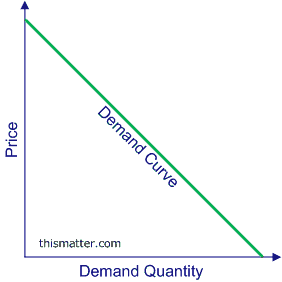
Fig 1: Demand curve
Veblen Goods
These goods oppose the law of demand i.e. higher price means lower demand but in these goods higher price increases the demand. These are snob goods or status symbols like limozine, gold where price increase means higher prestige to the buyer and so demand increases.
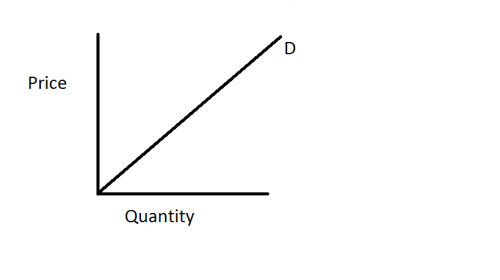
Fig 2: Veblen goods demand curve
Giffen goods
These too are goods that show behavior like Veblen goods in terms of the abnormal demand curve i.e. demand increases with price. However unlike Veblen goods these aren't snob goods or status symbols.A Giffen good is an inferior good with no close substitute available.
Hypothetical example Bread is a good food source for people and when its price increases the people are forced to cut out other eatables like meat and spend more on bread. Hence its demand increases with price. But in reality its difficult to find genuine examples of Giffen goods.
Types of elasticity:
Price elasticity -This means increase in price of A by X% reduces his demand by X%. However goods can be perfectly inelastic too i.e. Water, food - where the company has a monopoly and so increase in price doesn't affect demand at all. Goods can also be perfectly elastic i.e. high competition where people buy all of a product X at a particular price but none at all if the price increases slightly. In real situations, goods can be relatively inelastic i.e. increase in price by 10% reduces demand by less than 10% and relatively elastic i.e. increase in price by 10% but demand reduced by more than 10%.
Income elasticity -If the salary rises by 10% then the demand for the good should rise by 10% [perfect elasticity], more than 10% [high elastic], less than 10% [low elastic].
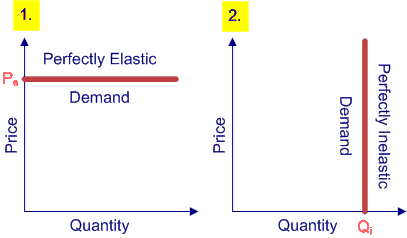
Fig 3: Price elasticity
Supply Curve
If the price offered for a good becomes more then the supply of it also increases.
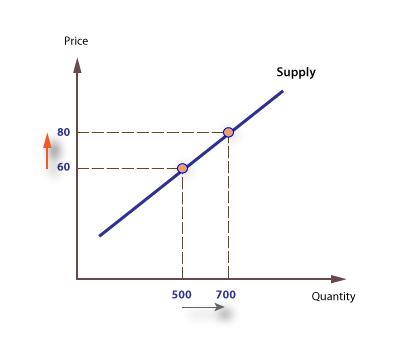
Fig 4: Supply curve
Types of Supply
- Perfectly inelastic: Price change can never affect the supply. E.g: Da vinci paintings
- Relatively inelastic: Price change by X% increases supply by less than X%.
- Unitary: Price change by X% increases supply by X% only.
- Relatively elastic: Price change by X% increases supply by more than X%.
- Perfectly elastic: Willing to supply infinite amount at a price but when price reduces supply becomes 0.
Relatively inelastic goods are perishables whereas relatively elastic are non perishables.
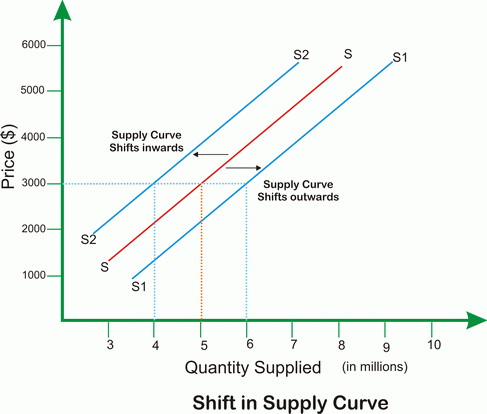
Quiz
Score more than 80% marks and move ahead else stay back and read again!